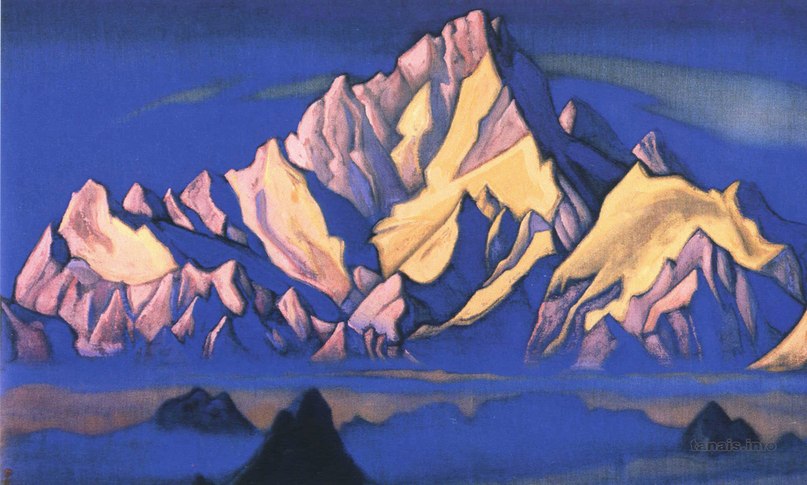
Nicholas Roerich’s house in Naggar has been transformed into a piece of art, his study, dining room and vintage car sealed in and accessible to tourists only so far. The ground floor of his picturesque mansion houses the many mountain studies he made with the Shivalik, the Dhauladhar and the Zanskaar ranges as subject.
He died in Naggar, in 1947, when he was seventy-three years old.
The gallery remains closed from one o’ clock to one-thirty in the afternoon.
I am going to start with a poem I wrote, while I was waiting for the gallery to reopen, having viewed the paintings for a short five minutes beforehand. I was sitting on a bench, opposite to the Roerichs’ locked vintage car, beneath the deodars through which the sun overflowed and pinched my skin. The sounds of the surging Beas came from the heart of the town of Naggar, the whole of which could be seen through the orchid bushes planted around the hill which enclosed the Roerichs’ old residence.
—————————————————
URUSVATI
What do I have to do,
To make these tremulous ink scratches of a muse,
Travel back half a century, over these same tendril-pressed stones,
When, perhaps the sun through these deodars was a little less strong?
There are so many, that carve boundaries between your time and mine –
The storm-loaded river, which speaks of some other side;
The red shawl of daybreak on the mountain-masts
In your painting of the Spiti Valley, where I couldn’t go.
Yet you come so near,
The movements of your hands in every brush stroke,
Every spillage of paint on every finished corner
Of tin roofs on Naggar houses growing from orchids,
Every dribble of grey vermillion down the ravines
Of every mountain study beneath skies of obstructed blue.
That is who you are, no lesser, no more than a morning star,
Beyond the reach of two ink-smelling hands,
Hands that hold a wind-coated rock from Lahaul
Like the religion of a thousand Buddhist monks –
Yet so near, to find in me
Starlight enough to write this now.
————————————-
Nicholas Roerich was a lover of mountains. He was born and educated in Russia, but his artistic legacy remains in the form of impressionistic paintings of the Himalayas. He used his colours very methodically. He had that perfect rose-gold hue of sunrise spilling over a mountain coated with snow. He had that perfect turgid, watery blue of evenings from whose wicker the flame of daylight is still releasing in smoky chokes.
We weren’t allowed to take photographs of his paintings, but copies are available online.
One of his paintings – the one that moved me most – was of Buddhist monks in red robes gathered like orchids at the corner of the bluish grey snowy plateau. It is titled, “Buddhist monks returning from Lahaul”. The waterfall was etched like the pleats of a silk saree, white in colour, blue in the folds. The mountains held a sharp shade of blue in which dabs of violet percolated.
I cannot tell, for sure, what it was in me that quivered on seeing that painting. Perhaps it was how the monks lay like fallen petals against the snow, a sigh of surrender in the nerves of the painting; perhaps it was the blue, or, perhaps it was my short-lived love affair with Lahaul just the day before, and the promise of how temporary things stay on permanently.
“Urusvati” means “star of the morning”, and is also the name of the institute of Himalayan studies the Roerichs founded. It is also the symbol of celestial constancy, and how human definitions of light and dark are illusions.



I’ve been meaning to read this for weeks, and I found this very pleasant.
LikeLiked by 1 person
Dear Madhura,
I had visited Naggar with my family during the summer of 2012. Your picturesque verses and vivid reflections on the works of Roerich brought back pleasant memories of the days spent there. Besides visiting the Roerich house, we also visited the Naggar Castle and camped there overnight. If you too have visited the castle, I would love to read your reflections on the sylvan serenity it offers, cradled cautiously, in the lap of the blue mountains.
Love,
Shilanjani
LikeLike
Shilanjani di,
Thank you so much for this.
I did visit Naggar Castle. The architecture was poetry. I have a lot of photographs from that place. I wasn’t too crazy about the crowd, but it was an enchanting place.
Lots of love.
Madhura
LikeLike